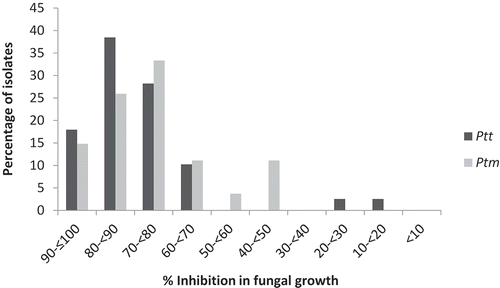Figures & data
Table 1. The effective concentration of propiconazole (mg L−1) required to inhibit fungal growth by 50% (EC50) in eight isolates each of Pyrenophora teres f. teres (Ptt) and P. teres f. maculata (Ptm).
Fig. 1 Dose response curve of the mean fungal growth inhibition of representative Pyrenophora teres f. teres and P. teres f. maculata isolates from western Canada in response to propiconazole (a) and pyraclostrobin (b). Eight and 12 isolates each of Ptt and Ptm, respectively, were employed in the experiments with propiconazole (16 isolates in total) and pyraclostrobin (24 isolates in total). Three replicate wells were included for each combination of isolate and concentration. Experiments were conducted twice, and the mean fungal growth inhibitions were averaged. Growth inhibition is relative to non-amended control treatments.

Table 2. Propiconazole sensitivity of Pyrenophora teres f. teres (Ptt) and P. teres f. maculata (Ptm) isolates collected in 2009–2012 from Alberta, Saskatchewan and Manitoba, Canada.
Fig. 2 Frequency distribution of inhibition of fungal growth in 39 Pyrenophora teres f. teres and 27 P. teres f. maculata isolates from western Canada in response to 5 mg L−1 propiconazole in potato dextrose broth. Inhibition of fungal growth is expressed as a percentage relative to a control treatment in which no propiconazole was included.

Table 3. The effective concentration of pyraclostrobin (mg L−1) required to inhibit fungal growth by 50% (EC50) in 12 isolates each of Pyrenophora teres f. teres and P. teres f. maculata.
Table 4. Pyraclostrobin sensitivity of Pyrenophora teres f. teres (Ptt) and P. teres f. maculata (Ptm) collected in 2009–2012 from Alberta, Saskatchewan and Manitoba, Canada.
Fig. 3 Frequency distribution of inhibition of fungal growth in 39 Pyrenophora teres f. teres and 27 P. teres f. maculata isolates from western Canada in response to 0.15 mg L−1 pyraclostrobin in potato dextrose broth. Inhibition of fungal growth is expressed as a percentage relative to a control treatment in which no pyraclostrobin was included. Experiments were performed in the presence of 100 mg L−1 salicylhydroxamic acid (SHAM).

